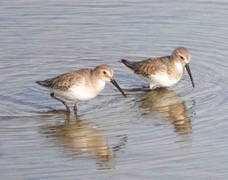Dunlin

ComingsBirds.com
to the beauty of birds

- Home California Birds
- SLIDESHOW
- SUMMARY OF ALL BIRDS
- MOVIES
- American Avocet
- American Coot
- Blackbirds/Crows
- Blue-grey gnatcatcher
- Brant
- Brown Pelican
- Chickade Mountain
- Comings' Backyard
- Common Loon
- Curlew Long-billed
- Dowitcher Long-billed
- Dowitcher Short-billed
- DUCKS
- EGRETS
- Dunlin
- Godwit Marbled
- Goldfinch Lesser
- GREBES
- Gnatcatcher Blue-grey
- Grosbeak Black-headed
- Gull California
- HUMMINGBIRDS
- Gull Heermann's
- Heron Black-crowned
- Heron Great Blue
- House Finch
- Jays
- Killdeer
- Merganser Red-breasted
- Nutcracker Clark's
- NutmegMannikin.com
- Other Birds
- Phainopepla
- Phoebe Say's
- Plover Black-bellied
- Plover Western Snowy
- Quail California
- Kittywake Black-legged
- Recent Additions
- Roadrunner Greater
- Sandpiper Least
- Sandpiper Western
- Sally's Fish
- Sanderling
- Shore Birds Other
- Skimmer Black
- Sparrow White-crowned
- Song Sparrow
- Stilt Black-necked
- Surf Scoter
- Swallow Tree
- Teal Blue-winged
- Teal Green-Winged
- Teal Cinnamon
- Tern Common
- Tern Elegant
- Turnstone Black
- Turnstone Ruddy
- Western Meadowlark
- Whimbrel
- Willet
- Yellow Leggs
- WOODPECKERS
- Template
- Contact Me
The Dunlin (Calidris alpina) is a small wader, sometimes separated with the other "stints" in Erolia. The English name is a dialect form of "dunling", first recorded in 1531–2. It derives from "dun", "dull brown ", with the -ling suffix meaning "concerned with". The genus name is from Ancient Greek kalidris or skalidris, a term used by Aristotle for some grey-colored waterside birds. The specific alpina is from Latin and means "of high mountains", in this case referring to the Alps.
It is a circumpolar breeder in Arctic or subarctic regions. Birds that breed in northern Europe and Asia are long-distance migrants, wintering south to Africa, southeast Asia and the Middle East. Birds that breed in Alaska and the Canadian Arctic migrate short distances to the Pacific and Atlantic coasts of North America, although those nesting in northern Alaska overwinter in Asia. Many dunlins winter along the Iberian south coast.
An adult dunlin in breeding plumage shows the distinctive black belly which no other similar-sized wader possesses. The winter dunlin is basically grey above and white below. Juveniles are brown above with two whitish "V" shapes on the back. They usually have black marks on the flanks or belly and show a strong white wingbar in flight.
The legs and slightly decurved bill are black.
The call is a typical sandpiper "peep", and the display song a harsh trill.
The dunlin is highly gregarious in winter, sometimes forming large flocks on coastal mudflats or sandy beaches. Large numbers can often be seen swirling in synchronized flight on stop-overs during migration or on their winter habitat.
This bird is one of the most common waders throughout its breeding and wintering ranges, and it is the species with which other waders tend to be compared. At 6.7–8.3 in length and with it is similar in size to a common starling, but stouter, with a thicker bill.
The dunlin moves along the coastal mudflat beaches it prefers with a characteristic "sewing machine" feeding action, methodically picking small food items. Insects form the main part of the dunlin's diet on the nesting grounds; it eats molluscs, worms and crustaceans in coastal areas.
Dunlin are small migratory waders, however they show strong philopatry. Philopatry is the tendency of an organism to stay in or habitually return to a particular area. The causes of philopatry are numerous, but natal philopatry, where animals return to their birthplace to breed, may be the most common.
© 2009 David Comings Contact Me
